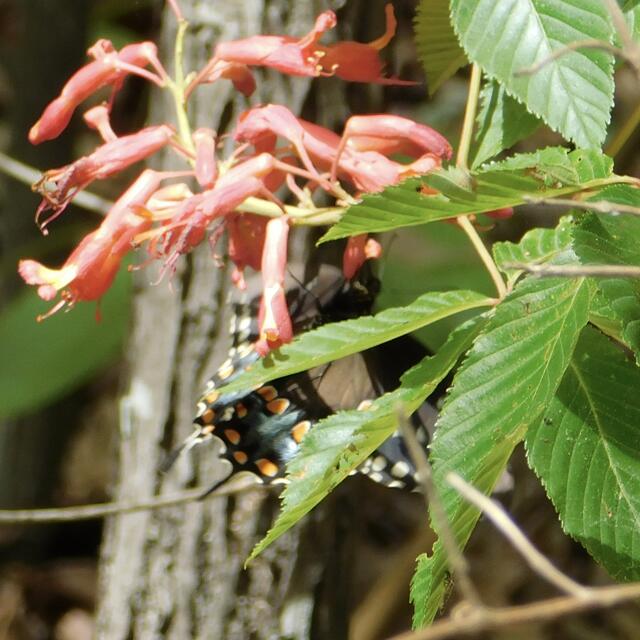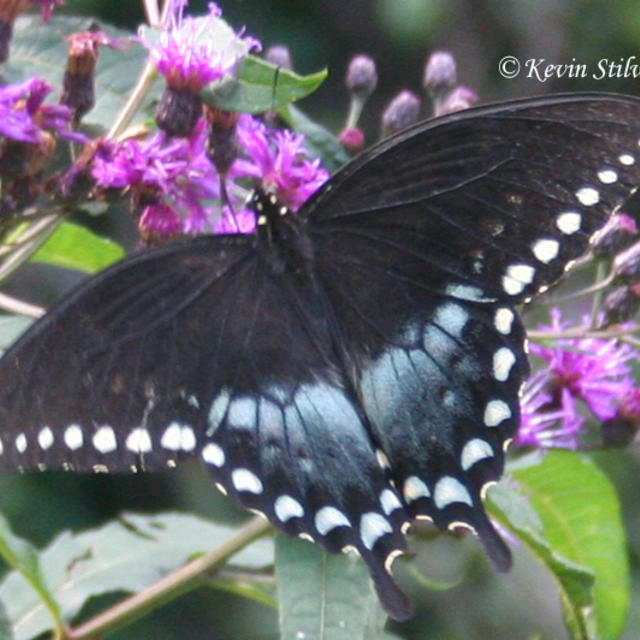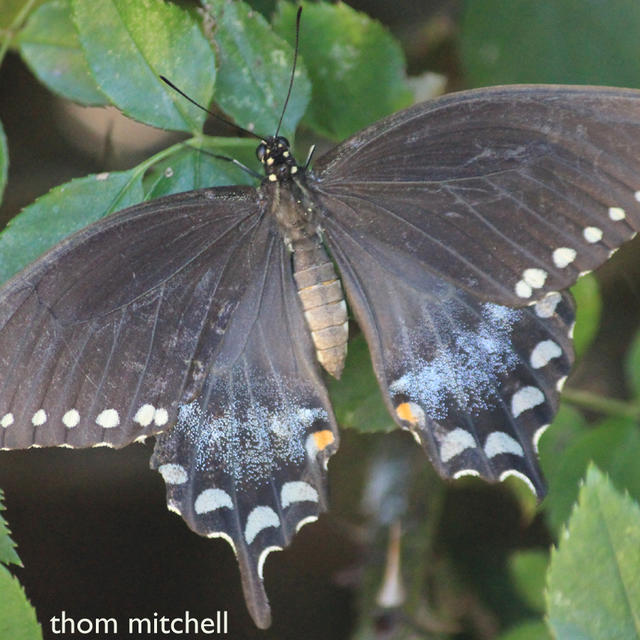Spicebush Swallowtail
Papilio troilus Linnaeus, 1758
Family: Papilionidae
Subfamily: Papilioninae
Identification: Upper surface of forewing is mostly black with ivory spots along margin. Upper surface of hindwing has orange spot on costal margin and sheen of bluish (female) or bluish-green (male) scales. Underside of hindwing with pale green marginal spots.
Wing Span: 3 - 4 inches (7.5 - 10 cm).
Life History: Males patrol in woods, roads and woodland edges to find receptive females. Females lay single eggs on underside of host plant leaves. Caterpillars live in shelters of folded-over leaves and come out to feed at night. Some chrysalids from each generation hibernate.
Flight: 2 generations per year from April-October. In Florida, several generations between March-December.
Caterpillar Hosts: Spicebush (Lindera benzoin), sassafras trees (Sassafras albidum); perhaps prickly ash (Zanthoxylum americanum), tulip tree (Liriodendron tulipifera), sweetbay (Magnolia virginiana), camphor (Cinnamomum camphora), and redbay (Persea borbonia).
Adult Food: Nectar from Japanese honeysuckle, jewelweed, thistles, milkweed, azalea, dogbane, lantana, mimosa, and sweet pepperbush.
Habitat: Deciduous woodlands, fields, roadsides, yards, pine barrens, wooded swamps, and parks.
Range: Eastern states from southern Canada to Florida; west to Oklahoma and central Texas. Occasionally strays to North Dakota, central Colorado, and Cuba.
Conservation: Not usually required.
NCGR: G5 - Demonstrably secure globally, though it may be quite rare in parts of its range, especially at the periphery.
Management Needs: None noted.
Get your BAMONA Gear!
Please donate!
We depend on donations to keep Butterflies and Moths of North America freely available. We want to express our gratitude to all who showed their support by making a contribution this year. You can donate to support this project at any time.
Advertise with us!
Do you have a product or service that you think would interest BAMONA users? If you would like to advertise on this website, contact us by email, or use the contact form and select the "Advertising" category.
Verified Sightings
Displaying 49 - 72 of 7824 verified sightings

Observation date: Jul 08, 2024
Submitted by: courtgwalsh
Region: Pike County, Pennsylvania, United States
Verified by: davidwright
Verified date: Jul 13, 2024

Observation date: Aug 20, 2023
Submitted by: danahoover
Region: Cambria County, Pennsylvania, United States
Verified by: davidwright
Verified date: Jul 13, 2024

Observation date: Jul 07, 2024
Submitted by: Lydiaak
Region: Allegheny County, Pennsylvania, United States
Verified by: davidwright
Verified date: Jul 13, 2024

Observation date: Jul 07, 2024
Submitted by: Lydiaak
Region: Allegheny County, Pennsylvania, United States
Verified by: davidwright
Verified date: Jul 13, 2024

Observation date: Jul 11, 2024
Submitted by: maryjanzen
Region: Centre County, Pennsylvania, United States
Verified by: davidwright
Verified date: Jul 13, 2024

Observation date: Jul 11, 2024
Submitted by: Jgrugeon
Region: Chester County, Pennsylvania, United States
Verified by: davidwright
Verified date: Jul 13, 2024

Observation date: Jul 01, 2024
Submitted by: Alison Davies
Region: Lexington County, South Carolina, United States
Verified by: Dennis Forsythe
Verified date: Jul 12, 2024

Observation date: Jul 09, 2024
Submitted by: Benjamin Miller
Region: Knox County, Ohio, United States
Verified by: rogerdowner
Verified date: Jul 10, 2024

Observation date: Apr 22, 2024
Submitted by: Ken Cheeks
Region: Edgefield County, South Carolina, United States
Verified by: Dennis Forsythe
Verified date: Jul 07, 2024

Observation date: Aug 30, 2020
Submitted by: danahoover
Region: Cambria County, Pennsylvania, United States
Verified by: davidwright
Verified date: Jul 06, 2024

Observation date: Aug 07, 2020
Submitted by: catbirdcat
Region: Carroll County, Maryland, United States
Verified by: jwileyrains
Verified date: Jun 21, 2024

Observation date: May 29, 2024
Submitted by: rapids
Region: Ontario, Canada
Verified by: jmgesell
Verified date: May 29, 2024

Observation date: May 25, 2024
Submitted by: Gingurr25
Region: Posey County, Indiana, United States
Verified by: jmgesell
Verified date: May 25, 2024

Observation date: May 22, 2024
Submitted by: jmgesell
Region: Northampton County, Pennsylvania, United States
Verified by: davidwright
Verified date: May 24, 2024

Observation date: Jun 29, 2023
Submitted by: John LeBlanc
Region: Chesterfield County, Virginia, United States
Verified by: jwileyrains
Verified date: May 22, 2024

Observation date: May 14, 2023
Submitted by: John LeBlanc
Region: Chesterfield County, Virginia, United States
Verified by: jwileyrains
Verified date: May 22, 2024

Observation date: Jul 08, 2022
Submitted by: Team-Chick
Region: Virginia, York County, United States
Verified by: jwileyrains
Verified date: May 22, 2024

Observation date: Aug 19, 2023
Submitted by: Team-Chick
Region: Virginia, York County, United States
Verified by: jwileyrains
Verified date: May 22, 2024

Observation date: May 16, 2024
Submitted by: pamkasper@duck.com
Region: Nassau County, New York, United States
Verified by: jmgesell
Verified date: May 16, 2024

Observation date: May 10, 2024
Submitted by: Erik Stabl
Region: Hillsborough County, Florida, United States
Verified by: John Calhoun
Verified date: May 11, 2024

Observation date: Apr 15, 2024
Submitted by: tiki33wv
Region: Athens County, Ohio, United States
Verified by: rogerdowner
Verified date: Apr 21, 2024

Observation date: Apr 14, 2024
Submitted by: Gingurr25
Region: Posey County, Indiana, United States
Verified by: jmgesell
Verified date: Apr 15, 2024

Observation date: Apr 07, 2024
Submitted by: DeepSkyKelly
Region: Bowie County, Texas, United States
Verified by: jwileyrains
Verified date: Apr 08, 2024

Observation date: Apr 05, 2024
Submitted by: Ken Cheeks
Region: Edgefield County, South Carolina, United States
Verified by: Dennis Forsythe
Verified date: Apr 05, 2024
- ‹ previous
- 3 of 326
- next ›














